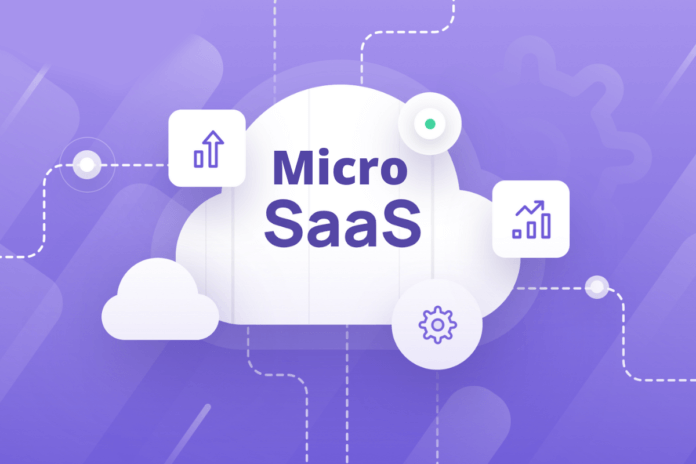In the ever-evolving landscape of software-as-a-service (SaaS) businesses, micro-SaaS has emerged as a promising avenue for entrepreneurs and innovators. With its focus on delivering specialized solutions to niche markets, micro-SaaS presents a unique opportunity to build a profitable Micro SaaS business in 2025.
The scalability, lower operating costs, and potential for high customer satisfaction make it an attractive option for aspiring business owners.
In this blog post, we will explore the essential steps and key strategies to help you navigate the path of building a successful and profitable micro-SaaS business in the current year.
From identifying the right niche to customer acquisition and retention, we’ll uncover the insights you need to thrive in the dynamic world of micro-SaaS. So, let’s dive in and discover the possibilities that lie ahead on your journey to micro-SaaS success.
But before jumping straight to step by step guide, let’s first understand what is Micro SaaS and why Micro SaaS is better than SaaS (Software as a service).
Micro SaaS: Definition| Meaning
Micro SaaS, also known as Micro Software as a Service, refers to a business model in which a company offers a specialized, niche software application as a service to a specific target market or customer segment. Unlike traditional SaaS companies that typically provide broad and comprehensive software solutions, Micro SaaS companies focus on delivering highly focused and specific applications.
The term “micro” in Micro SaaS implies the size and scope of the business. Micro SaaS companies are usually small-scale operations, often consisting of a single founder or a small team. They aim to solve a specific problem or cater to a specific need within a niche market, leveraging the advantages of cloud computing and the SaaS delivery model.
Micro SaaS businesses typically have the following characteristics:
- Niche focus: They target a specific industry, market, or customer segment, addressing a particular pain point or requirement.
- Specialized functionality: Micro SaaS applications are designed to offer a limited set of features or functionalities, but they excel at addressing the specific needs of their target audience.
- Scalable infrastructure: These companies leverage cloud infrastructure to deliver their software as a service, allowing them to scale and accommodate growing user bases without the need for significant upfront investment.
- Lean operations: Micro SaaS companies often have small teams and keep their operational costs low by focusing on a single product or service.
- Self-funded or bootstrapped: Many Micro SaaS businesses are self-funded or rely on bootstrapping methods rather than seeking external funding.
- Integration-friendly: Micro SaaS applications are often designed to integrate with other tools and platforms, allowing users to enhance their existing workflows and systems.
Micro SaaS can be an attractive business model for entrepreneurs looking to enter the software market with a specialized offering. It allows for focused development, targeted marketing, and the potential to capture a specific segment of customers who may have unique requirements not met by larger, more generalized software solutions.
Why Is Micro-SaaS Better Than SaaS?
Whether Micro SaaS is better than traditional SaaS depends on various factors and the specific context in which they are considered. While both models have their advantages and disadvantages, Micro SaaS offers certain benefits that may be appealing in certain situations. Here are some reasons why Micro SaaS can be advantageous:
Niche Market Focus:
Micro SaaS companies target specific niches or customer segments, allowing them to deeply understand the needs of their target audience. By catering to a narrow market, they can offer specialized functionality that may not be available in broader SaaS solutions. This focus can lead to a more tailored and customized user experience, which can be highly valuable to customers with specific requirements.
Agility and Flexibility:
Micro SaaS companies are often small and agile, enabling them to adapt quickly to customer feedback and market demands. They can iterate and release updates more rapidly than larger SaaS providers, allowing them to address issues, add new features, and stay ahead of the competition.
Lower Costs and Pricing:
Micro SaaS businesses typically have lower operating costs compared to larger SaaS companies. They often require fewer resources, have leaner operations, and may not need significant infrastructure investments. This can result in more affordable pricing for customers, making the Micro SaaS solution a cost-effective option, especially for smaller businesses or startups with budget constraints.
Integration and Customization:
Micro SaaS applications are often designed to be easily integrated with other tools and systems. This flexibility allows users to enhance their existing workflows by combining different software solutions. Additionally, Micro SaaS companies may be more willing to provide customization options or offer personalized support to meet specific customer needs.
Market Differentiation:
In competitive markets, Micro SaaS can differentiate itself by providing unique features or addressing niche requirements that larger SaaS providers may overlook. This can give Micro SaaS companies a competitive advantage and attract customers who are seeking specialized solutions tailored to their specific industry or use case.
Also, these key factors are the reason for the gaining popularity of Micro SaaS Businesses.
It’s important to note that Micro SaaS is not inherently “better” than traditional SaaS. Traditional SaaS has its own advantages, such as comprehensive functionality, scalability for large enterprises, and established market presence. The choice between Micro SaaS and traditional SaaS depends on the specific needs and priorities of the target audience and the goals of the business.
How To Start Micro SaaS Business?
The SaaS industry is booming, and Micro-SaaS businesses are emerging as a viable and profitable option for entrepreneurs. A Micro-SaaS business is a small software product that solves a specific problem for a niche audience. These businesses have lower overhead costs, can be bootstrapped, and have the potential to generate significant revenue.

1. Identifying a Profitable Micro-SaaS Idea
Researching the market and identifying niche opportunities is crucial for the success of your Micro-SaaS business. Here’s how you can go about it:
- Researching the market and analyzing competitors: Explore underserved industries or pain points that haven’t been addressed by existing solutions. Analyze the competitor landscape to identify gaps that you can fill with your unique product.
- Evaluating market demand: Conduct customer interviews and surveys to understand their needs and challenges. Analyze keyword search volume and trends to gauge the market demand for your idea.
- Assessing feasibility and scalability: Consider the technical requirements and development complexity of your idea. Evaluate potential revenue streams and pricing models to ensure profitability.
2. Defining Your Target Audience and Value Proposition
To succeed in the Micro-SaaS space, you must clearly define your target audience and craft a compelling value proposition. Here’s how to do it:
- Identifying your target audience: Conduct in-depth market research and analysis to understand the demographics, psychographics, and pain points of your potential customers.
- Understanding customer needs: Dive deeper into your target audience’s specific needs and challenges. This can be achieved through customer interviews, surveys, and analyzing user feedback.
- Crafting a compelling value proposition: Highlight the unique features and benefits of your Micro-SaaS product. Show how your solution solves the customer’s problem effectively and efficiently. Differentiate yourself from competitors by emphasizing your unique selling points.
3. Building and Launching Your Micro-SaaS Product
Now that you have a solid idea and target audience, it’s time to build and launch your Micro-SaaS product. Here’s a step-by-step approach:
- Defining the minimum viable product (MVP) features: Identify the core features that address the immediate needs of your target audience. This allows you to launch quickly and gather user feedback for further improvements.
- Choosing the right technology stack and development approach: Select the appropriate technology stack and development approach that aligns with your product requirements. Consider factors such as scalability, ease of maintenance, and cost-effectiveness.
- Creating a user-friendly interface: Design a seamless user experience (UX) that makes it easy for customers to navigate and use your product. Incorporate user feedback through iterative development to continuously improve the user interface.
- Implementing robust security and data protection measures: Prioritize the security of customer data. Ensure compliance with relevant regulations, such as GDPR, and conduct regular security audits and updates to protect user information.
- Beta testing and gathering user feedback: Set up a beta testing program to gather feedback from real users. This helps you identify bugs or usability issues and allows you to make necessary improvements before the official launch.
You can use the BufferApps Platform for Beta Testing as it offers a beta launch for Micro SaaS products. BufferApps has a huge community of makers and entrepreneurs, which will help you in a successful product launch. It is best to gain honest user feedback, more exposure and eyeballs, early adopters and customers for your product. - Preparing a strategic marketing plan: Develop a comprehensive marketing plan to create awareness and generate interest in your product. Define your target marketing channels, create compelling messaging, and leverage content marketing, social media, and other platforms to create buzz.
4. Acquiring and Retaining Customers
Once your product is launched, acquiring and retaining customers becomes crucial. Here’s how you can do it effectively:
- Developing a customer acquisition strategy: Identify the most effective digital marketing channels to reach your target audience. This may include SEO, PPC advertising, social media marketing, and content marketing. Consider partnering with influencers and industry experts to expand your reach.
- Enhancing customer onboarding and support: Provide a seamless onboarding experience for new customers. Offer comprehensive documentation, tutorials, and personalized assistance to help them get started with your product. Ensure responsive customer support through multiple channels to address any queries or issues promptly.
- Implementing customer retention strategies: Continuously improve your product based on user feedback to meet evolving customer needs. Offer incentives, loyalty programs, or exclusive features to encourage customers to stay with your Micro-SaaS business. Building strong customer relationships through personalized communication is essential for customer retention.
5. Scaling and Monetizing Your Micro-SaaS Business
As your Micro-SaaS business grows, scaling and monetizing becomes crucial. Here’s how you can achieve sustainable growth:
- Scaling the infrastructure and resources: Ensure your infrastructure can handle increased user demand. Optimize server infrastructure and leverage cloud services for scalability and reliability.
- Implementing pricing strategies for profitability: Determine the right pricing model for your product, such as subscription, tiered, or usage-based. Conduct pricing experiments and A/B testing to find the optimal pricing strategy that aligns with your business goals and customer expectations.
- Expanding the product offering and exploring new markets: Identify additional features or modules that complement your existing product and provide more value to your customers. Research international markets and localization opportunities to broaden your customer base.
- Leveraging partnerships and integrations: Collaborate with complementary SaaS providers to offer bundled solutions or cross-promote each other’s products. Integrating with popular platforms can help you tap into new markets and attract new customers.
What Are Successful Micro SaaS Companies?
There are several successful micro SaaS companies that have emerged in recent years. Here are a few examples:
- “Calendly”: A scheduling and appointment management micro SaaS that has gained significant popularity. It simplifies the process of setting up meetings and managing schedules for individuals and teams.
- “ConvertKit”: A micro SaaS focused on email marketing and automation for content creators, such as bloggers and online course creators. It offers targeted features to help manage email campaigns and build audience engagement.
- “Buffer”: A micro SaaS that enables social media management and scheduling. It allows users to plan, create, and schedule social media posts across various platforms, providing tools to analyze and optimize social media performance.
- “Zoom”: While it started as a video conferencing solution, Zoom can be considered a successful micro SaaS business. It provides a reliable platform for remote meetings, webinars, and collaboration, catering to the evolving needs of remote work and virtual communication.
- “Stripe”: A micro SaaS that offers online payment processing and financial tools for businesses. It simplifies the process of accepting payments, managing subscriptions, and handling complex financial transactions.
These examples demonstrate the success of micro SaaS businesses that have identified specific market needs, built specialized solutions, and effectively served their target audience.
Conclusion
Building a profitable Micro-SaaS business requires careful planning and execution. By following the steps outlined in this guide, you’ll be well-equipped to navigate the competitive SaaS landscape in 2025. Remember to continuously listen to your customers, refine your product, and adapt to changing market dynamics. Success in the Micro-SaaS industry awaits those who are passionate, innovative, and persistent. Get started today and embark on your journey to building a thriving Micro-SaaS business!
FAQs – Micro SaaS Business
Micro SaaS businesses are niche-focused SaaS companies with specialized offerings for specific audiences. They have small teams, low costs, and target a narrow market with tailored solutions.
To find a micro SaaS niche, consider the following steps:
Identify your interests and expertise
Research market demand
Narrow down your target audience
Validate your idea
Assess competition
Develop a minimum viable product (MVP)
Remember, finding a micro SaaS niche requires a combination of research, understanding customer needs, and identifying gaps in the market. Continuously iterate and adapt based on user feedback to build a successful micro SaaS business.
The time to build a micro SaaS business can range from a few months to a year or more, depending on factors like complexity, team size, and your experience.
To generate micro-SaaS ideas, consider the following approaches:
Identify pain points
Leverage personal experiences
Follow emerging trends
Conduct market research
Seek feedback and collaboration
Think niche and specific
Remember, creativity and a deep understanding of a specific domain are key to generating micro-SaaS ideas. Explore various sources, be open to feedback, and validate your ideas with potential customers to increase the chances of success.
Here are a few examples of micro SaaS businesses:
TaskHive
EventBook
DocuFlow
FitnessTracker
PetPals
These examples show how micro SaaS companies tailor solutions for specific industries or niches to fit their customers’ demands.
Micro SaaS refers to small software-as-a-service businesses that provide specialized solutions to a specific target audience. Unlike traditional SaaS companies, they offer niche applications with focused value propositions, typically operated by small teams with low costs.

